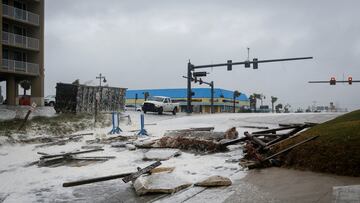When did Hurricane Nicole touch down in Florida and where?
Another tropical storm has struck the east coast of the United States, prompting tornado and flood warnings from the National Weather Service.


Florida’s east coast was struck by Hurricane Nicole in the early hours of Thursday morning and at least 45 of the state’s 67 counties have declared a state of emergency.
Soon after reaching land the system weakened to a tropical storm but it is still causing concern for Florida residents in the wake of Hurricane Ian. Nicole became the 14th named storm of the Atlantic hurricane season when it formed in the southwestern Atlantic Ocean earlier this week.
As a result of the tropical storm roughly 330,000 Floridians are currently without power and high winds cause problems in the region.
At Cape Canaveral, NASA’s Florida base, the Artemis space rocket was subjected to 100mph winds on Wednesday night. A statement from the space agency confirmed that the Space Launch System (SLS) rocket would remain on the launchpad at the Kennedy Space Center, but that they were continuing to consult forecast data.
Hurricane Nicole made landfall in Florida overnight and was quickly downgraded to a tropical storm. The sprawling weather system was battering the state with high winds, heavy rain and life-threatening coastal flooding as it moved west. https://t.co/9EXkGEKFXm pic.twitter.com/c6D2n11mZb
— The New York Times (@nytimes) November 10, 2022
Where will Tropical Storm Nicole hit next?
The tropical system hit Florida first but there is now thought to be an elevated risk of tornadoes along areas in the southeast of the United States. The National Weather Service (NWS) warned that multiple tornadoes are possible in south-eastern Georgia and both North and South Carolina on Thursday evening and into Friday morning.
The NWS also issued a public advisory on Thursday to warn of the risk of large tidal swells caused by Nicole. It is thought that the northwestern Bahamas and the southeastern coast of the United States are most at risk.
“These swells are likely to cause life-threatening surf and rip current conditions,” the NWS said.
Related stories
Along certain stretches of the coast the swell could reach up to 5 feet above ground as the storm surge floods usually dry areas.
The NWS has advised: “The deepest water will occur along the immediate coast near and to the north of the landfall location, where the surge will be accompanied by large and destructive waves.”

